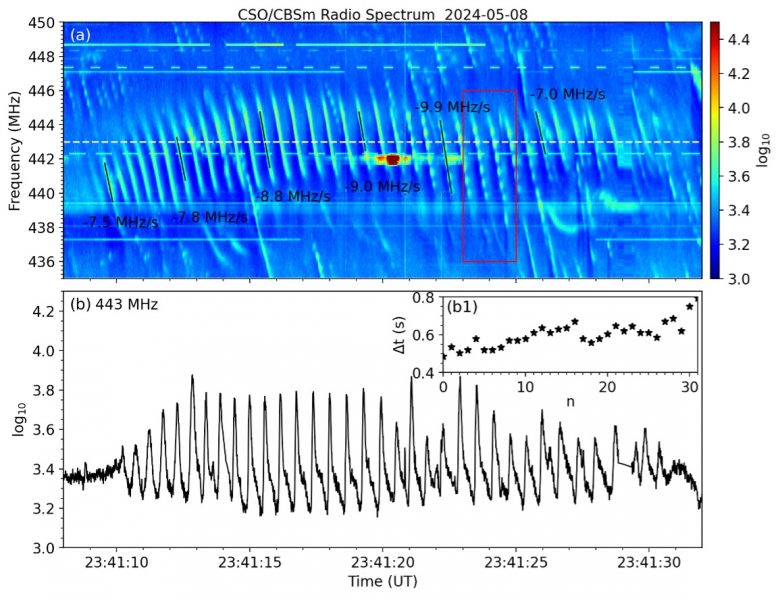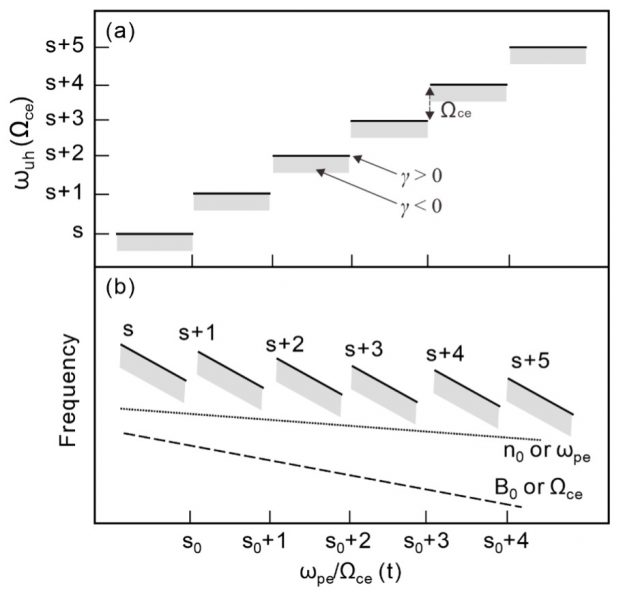Substantial fine structures, such as zebras, drifting bursts, spikes, and fibers have been reported during the past decades of observations of solar radio bursts. These fine structures are frequently associated with the wide-band continuum such as type-IV bursts, at both metric and decametric wavelengths. They carry important information about the radiation process and coronal conditions.
Previous studies have reported the so-called narrow-band stripes (e.g., Chernov 2008), characterized by a group of parallel-drifting stripes with relatively narrow spectral band (i.e., $\Delta \omega/ \omega < 0.1 $). The stripes often appear in chain, being separated by $\sim$<1 s on average and each one lasting for several to tens of seconds. They usually have negative drift, frequently accompanied by radiation depression (or absorptions) on the low-frequency side. Several mechanisms have been proposed to explain these features, yet the origin of their periodicity and coherence remains elusive.
The Chashan broadband solar radio spectrometer at meter wavelength (CBSm), an instrument of the Chinese Meridian Project-Phase II (CMP-II), has high frequency-temporal resolution (76.29 kHz, 0.84 ms) and sensitivity, making it a leading instrument for detecting fine structures in solar radio spectra (Chang et al. 2024). With CBSm data, we identified a novel spectral fine structure of solar type-IV burst. The structure is characterized by beaded (or pearl-like) enhancements, along a group of periodic narrow-banded stripes, termed as “beaded stripes” (see Figures 1 and 2). The recurrence time of stripes is $< 1$s (occasionally reaching 8s), often drifting from high to low frequencies and accompanied by absorptions, with trailing stripes appearing at the end of preceding ones. The beaded enhancements have a periodicity of $\sim$0.1s.
For the periodicity and coherence of these stripes, we proposed the following generation mechanism on the basis of the double plasma resonance (DPR) instability, and explained the beaded enhancements in terms of modulation by low-frequency magnetohydrodynamic (MHD) waves.
The DPR instability can excite the upper hybrid (UH) waves, in the presence of energetic electrons with unstable velocity distribution functions such as the beam-ring, horseshoe, or loss-cone. The UH waves have the most-efficient growth at frequency close to $\omega_{UH}$ when $\omega_{UH} \approx s\Omega_{ce}$, in overdense plasmas with $\omega_{pe}/\Omega_{ce} \gg 1$ (e.g., Li et al. 2019), where $s$ is a positive integer. Temporal variations in plasma density ($n_0$) and/or magnetic field strength ($B_0$) can modulate the values of $\omega_{pe}/\Omega_{ce}$. Once $\omega_{pe}/\Omega_{ce} $ varies by a unity, i.e., from $s$ to $s+1$ or $s-1$, we have excitations of successive UH harmonics of ($s \pm 1$) $\Omega_{ce}$. These recurring harmonics (along with the variations of $n_0$ and $B_0$) explain the chained stripes, as schemed in Figure 3. The absorption feature corresponds to the negative growth of the UH waves.
We attributed the beaded or pearl-like enhancements to periodic modulations by low-frequency MHD waves with a frequency of $\sim$10 Hz. Such modulations vary the background magnetic field and/or plasma density periodically and modulate the UH mode growth rate at the same pace, leading to the beaded feature.
We demand an elaborate numerical model to evaluate the growth rates of the DPR modes and the radiation modes, considering temporal variation or inhomogeneous distribution of plasma density or magnetic field strength, as well as the modulations of low-frequency MHD waves, to achieve a better understanding of the spectral structure.
The study informs the possibility to identify novel spectral fine structures with instruments of high sensitivity and spectral-temporal resolution, even after a persistent observation for several decades. In future, we will continue to search for novel spectral structures with CBSm.

Figure 1. (a) and (b) CBSm dynamic spectra containing rich fine structures. (c)–(e) Zoom-in views of the selected regions (black boxes in (a) and (b)).

Figure 2. (a) An example of stripes with an overall wavy morphology in the May 8, 2024 event, with beaded structure emerging in the middle portion. The black lines are fittings of the stripe slopes. (b) Intensity profile at 443 MHz (white dashed line in panel (a)). The inset (panel (b1)) shows the interval $\Delta$t between adjacent peaks.

Figure 3. Schematic diagram for the generation of striped chains. (a) Variations of the UH mode frequency as function of $\omega_{pe}/\Omega_{ce}$ (t). The shadows represent the absorptions, and $\gamma$ denotes the growth rate. (b) Schematic of chain formation due to the variations of $\omega_{pe}/\Omega_{ce}$ (t).
Based on a recently published article: C. Li, Y. Chen, B. Wang, Z. Zhong, B. Tan, Z. Ning, H. Ning, X. Kong, S. Chang, Y. Tang, N. Gai, L. Deng, J. Yan, and F. Yan, A novel fine spectral structure of solar radio bursts with periodic beaded stripes observed by CBSm of CMP-II, Sci. China-Phys. Mech. Astron. 68(10), 109611 (2025), DOI: 10.1007/s11433-025-2716-4, https://arxiv.org/abs/2506.06819
Additional info
The CBSm data can be accessed via the website:
http://47.104.87.104/MWRS/RadioBurstEvent/typeII/typeIIburst_show.html
References
- P. Chernov, 2008, ApJL, 34, 486
- W. Chang, B. Wang, G. Lu, et al., 2024, ApJS, 272, 21
- Li, Y. Chen, X. Kong, et al., 2019, ApJ, 880, 31
*Full list of Authors: Chuanyang Li, Yao Chen, Bing Wang, Ze Zhong, Baolin Tan, Zongjun Ning, Hao Ning, Xiangliang Kong, Shuwang Chang, Yanke Tang, Ning Gai, Li Deng, Jingye Yan, and Fabao Yan
